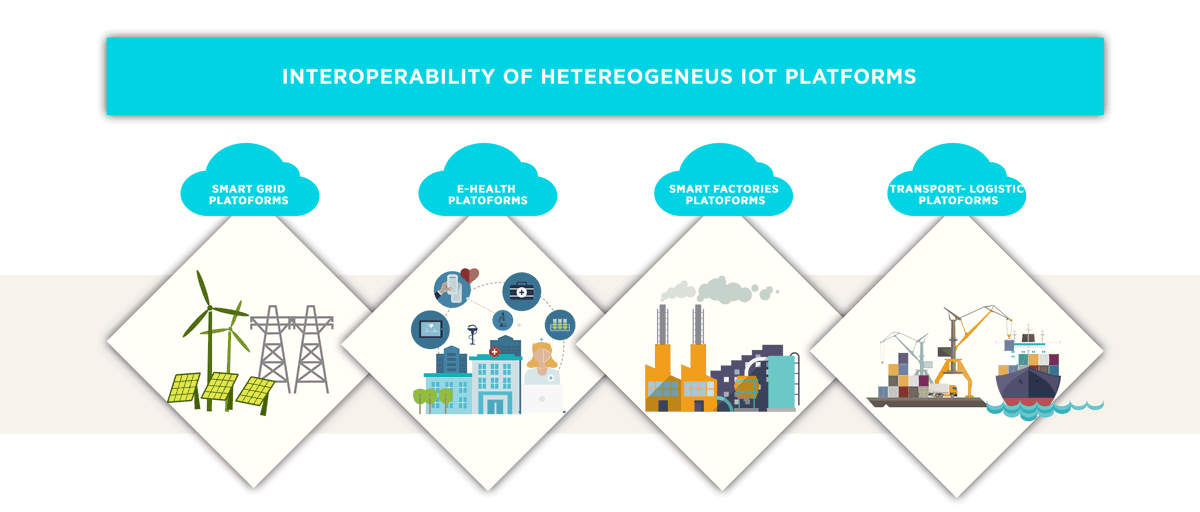
The overall goal of the INTER-IoT project is to provide an interoperable and open IoT framework, with associated engineering tools and methodology, for seamless integration of heterogeneous IoT platforms, regardless of the application domains.
INTER-IoT uses a layer- oriented approach.
INTER-IoT OBJECTIVES

Design and Implementation of an Open Cross-Layer Framework for Interoperability of IoT Platforms.
The interoperability framework (INTER-FW) will address interoperability issues between different heterogeneous IoT platforms. By using the INTER-FW, any IoT platform can be made interoperable with respect to its fundamental layers: device, networking, middleware, applications, and semantics. INTER-FW will facilitate creation of an ecosystem of interoperable and open IoT platforms. Thus, development time of novel IoT services and applications can be shortened, ad these services can be provided atop interoperable IoT platforms. Furthermore, from a business point of view, interoperability will result in lower costs.

Definition of Techniques and Tools for interoperability at the different IoT Platform Layers.
Layer (and cross-layer) interoperability is fundamental to provide a global continuum between IoT platforms. To address layer interoperability, the following activities will be carried out:
- design of device-to-device interaction based on multiprotocol/access mechanisms;
- design of software defined interoperable modules for mobility and routing;
- development of an open service discovery and management framework for smart objects;
- design and implementation of smart IoT application service gateway and virtualization;
- definition of a common ontology which will facilitate access to the heterogeneous data, which will be collected and managed by integrated IoT platforms.

Definition of a CASE-driven Engineering Methodology Driving the Application of the IoT Platform Interoperability Framework. .
INTER-IoT will define a special-purpose, systematic methodology (INTER-METH) that will enable (semi)automation of application of the INTER-FW framework for making heterogeneous IoT platforms interoperate, and guide the process. To support application of INTER-METH, a CASE (Computer Aided Software Engineering) tool will be implemented. It will help automate each phase (analysis, design, implementation, deployment, test, maintenance) of the integration process, using the INTER-METH, providing guidelines, graphical facilities, engineering patterns, and project data repositories.

Design and Implementation of an Integrated Interoperable Open Platform for Transport and Logistics in Port Environments (INTER-LogP).
By using the INTER-FW framework (and the related methodology and tools), we will experimentally make three representative, selected, and heterogeneous IoT platforms interoperate: the group of IoT platforms deployed in the port premises for daily activity management through the PCS (Port Community System), including environmental monitoring; SEAMS at NOATUM container terminal management and I3WSN developed by the UPV. INTER-LogP will be the result of using INTER-IoT in a specific application domain providing support among others to containers, trucks, environmental platforms, with the main goal to improve different indicators through a fully working interoperable platform.

Design and Implementation of an Integrated Interoperable Open Platform for Mobile Health Monitoring (INTER-Health)
INTER-IoT will use the INTER-FW framework (and the related methodology and tools), in order to make interoperate two representative and heterogeneous IoT platforms: one developed for static remote health-care (health-care center-to-home) and one specifically focused on health monitoring in mobility (everywhere, anytime). The integrated open platform (INTER-Health), will support health monitoring at health-care center through the center facilities, at home through a set of medical consumer devices, and in mobility based on body sensor networks. In order to evaluate the integration from functional and non-functional perspectives, atop the interoperable platform, we will develop and deploy in a controlled medical testbed, a fully-working application use case, related to the lifestyle monitoring. The application use case will therefore have its own specific objectives to improve and overcome the currently available methods, instruments and protocols.

Successful completion of field trials
The INTER-IoT developed pilots (Objectives 4 and 5) will be further evaluated in the two proposed application domains in: Nichelino (Turin) (IT) for m-health and Valencia (ES) for port transportation. Additionally a cross-domain use case and associated field trial will be performed in order to proof extendibility and interoperability of platforms from different application domains. Moreover, the project will analyse the provided solutions from the perspective of relevant stakeholders by considering their specific benefits, requirements, and constrains, and involving stakeholders from other application domains in order to evaluate the extendibility of the results.






